Destination - Barcelona
"Visiting Barcelona is not just going to touristic places but discovering the hidden corners not listed in the travel guides."
Unknown
"My favorite thing is to go where I've never been."
Lonely Planet

Unknown
"My favorite thing is to go where I've never been."
Lonely Planet

I haven't added anything to my destination series in quite awhile. But we are planning a trip to Barcelona, Spain in the spring. Our friends from Scotland will be meeting us there. I have been looking at things to do while there. So I figured that while I am looking, maybe I should put some of that information into the blog, and have that information available to anyone who reads this blog. And even though I will be listing all the touristy spots that everyone should see while in Barcelona, remember that you haven't really seen a place if all you do is explore the tourist spots. Its important to take the time to wander off the beaten path, into neighborhoods, and back streets. Get into areas where the people of the city live and work and eat. Try to make some time to talk to the people who live there, to make that contact with another person from another country. It is how we learn more about each other.
We will probably spend a week in the Barcelona area. I am thinking that at least 2 of those days we will make day trips to nearby areas. So I will be researching those also. Below are the most popular tourist things to do in Barcelona according to my research.
We will probably spend a week in the Barcelona area. I am thinking that at least 2 of those days we will make day trips to nearby areas. So I will be researching those also. Below are the most popular tourist things to do in Barcelona according to my research.
Basilica de la Sagrada Familia :
 The most popular and probably most famous attraction in Barcelona is the La Sagrada Familia which attracts nearly 2.8 million visitors each year. It is a large and intricate basilica designed by Gaudi. Construction began in 1882 and continues to this day. The building is predicted to be completed within the next 30 years. A glorious exterior and interior make this a place you have to visit.
The most popular and probably most famous attraction in Barcelona is the La Sagrada Familia which attracts nearly 2.8 million visitors each year. It is a large and intricate basilica designed by Gaudi. Construction began in 1882 and continues to this day. The building is predicted to be completed within the next 30 years. A glorious exterior and interior make this a place you have to visit.However, it is such a popular place that the lines can be long. It is not unusual to be in line for 2 or more hours. In addition to the problem of long entrance queues, if the Sagrada Familia reaches capacity it will not permit more visitors to enter for safety reasons. This means that even after standing in a long queue for hours you could be further delayed while the Basilica empties to a safe number of visitors. There is a way to avoid those lines. You can purchase your tickets online. Here is the link for the Skip the Line tickets :
http://partner.city-discovery.com/en/3255/barcelona/PID9120-Skip_the_Line_La_Sagrada_Familia_Guided_Tour
La Rambla:
 This is probably the city’s most famous street and is a bustling hive of activity. It is often called Las Ramblas, because it is actually a series of several different streets that all have a distinct feel. Located just off Plaza Catalunya and leading right down towards the port and beach, visitors will find street performers, lots of bars and restaurants and the fabulous Boquería Market. For a tourists' first visit, sitting on the Ramblas with a jug of sangria is an absolute must.
This is probably the city’s most famous street and is a bustling hive of activity. It is often called Las Ramblas, because it is actually a series of several different streets that all have a distinct feel. Located just off Plaza Catalunya and leading right down towards the port and beach, visitors will find street performers, lots of bars and restaurants and the fabulous Boquería Market. For a tourists' first visit, sitting on the Ramblas with a jug of sangria is an absolute must.La Rambla is primarily pedestrianized with only two narrow one-way traffic roads which run on either side of the central Ramblas Boulevard. Barcelona city council have restricted traffic flow through this region and you have the overwhelming feeling that pedestrians rule in this area (which makes a welcome change). Unlike other cities that have huge roads running through the middle Barcelona has chosen to structure the road system such that the heart of the city centre is primarily pedestrianized with larger roads that service the periphery.
If you are looking for some speciality items, practically anything, from an electricity adapter, special camera batteries, clothing, or even stationary items difficult to find in a regular shop you will probably find it in El Corte Inglés, which is a large department store in the Plaça Catalunya square If you can't find what you're looking for in El Corte Ingles, you can't find it anywhere.
The Las Ramblas is also famous for its many street artists. It is an interesting area to just wander around in, and is the heart of the city.
Casa Mila:
 Casa Mila is popularly known as‘La Pedrera’ (the stone quarry). The colorful building is considered one of the artist’s most eccentric and enticing architectural creations with not one straight edge on the exterior. It was constructed between 1906 and 1912 by Gaudi. In 1984 it was inscribed on the UNESCO World Heritage List, for its exceptional universal value. Tours of the interior and the incredible roof structures are available. It also hosts a large exposition of Gaudi works, covering Sagrada Familia and Casa Batlio, not only La Pedrera itself.
Casa Mila is popularly known as‘La Pedrera’ (the stone quarry). The colorful building is considered one of the artist’s most eccentric and enticing architectural creations with not one straight edge on the exterior. It was constructed between 1906 and 1912 by Gaudi. In 1984 it was inscribed on the UNESCO World Heritage List, for its exceptional universal value. Tours of the interior and the incredible roof structures are available. It also hosts a large exposition of Gaudi works, covering Sagrada Familia and Casa Batlio, not only La Pedrera itself.Parc Guell:
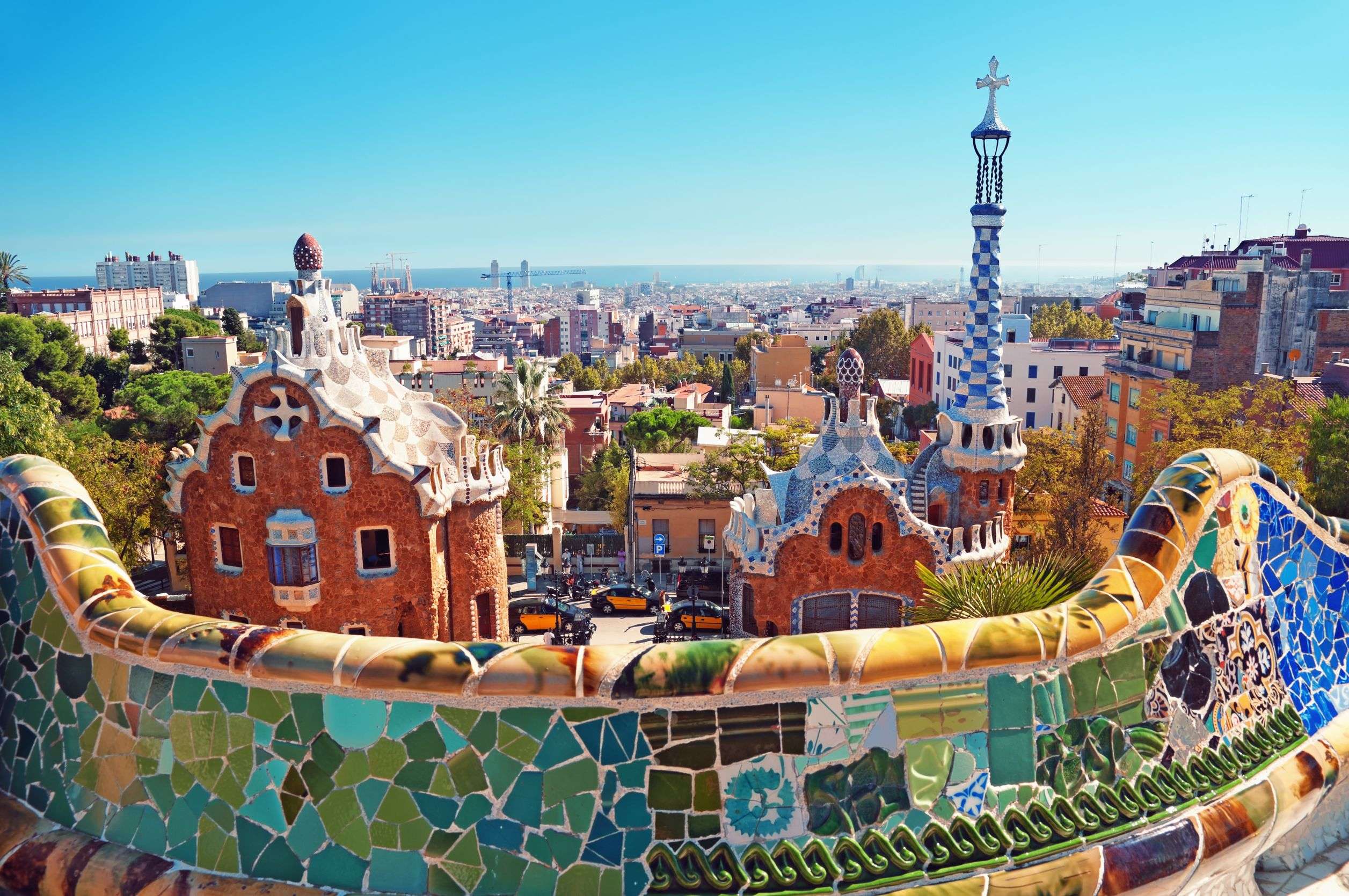 Located in the city of Barcelona, the Park Guell is one of the most beautiful icons of the city. It is the work of Antoni Gaudi and is located in the upper part of Barcelona, which has wonderful views of the city. It was originally meant to be a residential property development with Gaudi doing much of the planning and landscape design. Only two houses were built and the land was later sold to the city of Barcelona and turned into a park. It is home to the famous Salamander sculpture, as well as other buildings and structures designed by the architect. The park has amazing stone structures and stunning tiling.
Located in the city of Barcelona, the Park Guell is one of the most beautiful icons of the city. It is the work of Antoni Gaudi and is located in the upper part of Barcelona, which has wonderful views of the city. It was originally meant to be a residential property development with Gaudi doing much of the planning and landscape design. Only two houses were built and the land was later sold to the city of Barcelona and turned into a park. It is home to the famous Salamander sculpture, as well as other buildings and structures designed by the architect. The park has amazing stone structures and stunning tiling.
 |
| Parc Guell. |
Like other famous places, there can be long lines to get into the park. You can purchase your tickets online ahead of time and avoid the lines. Here is the link to purchase tickets:
http://www.parkguell.cat/en/buy-tickets/
The Casa Batllo:
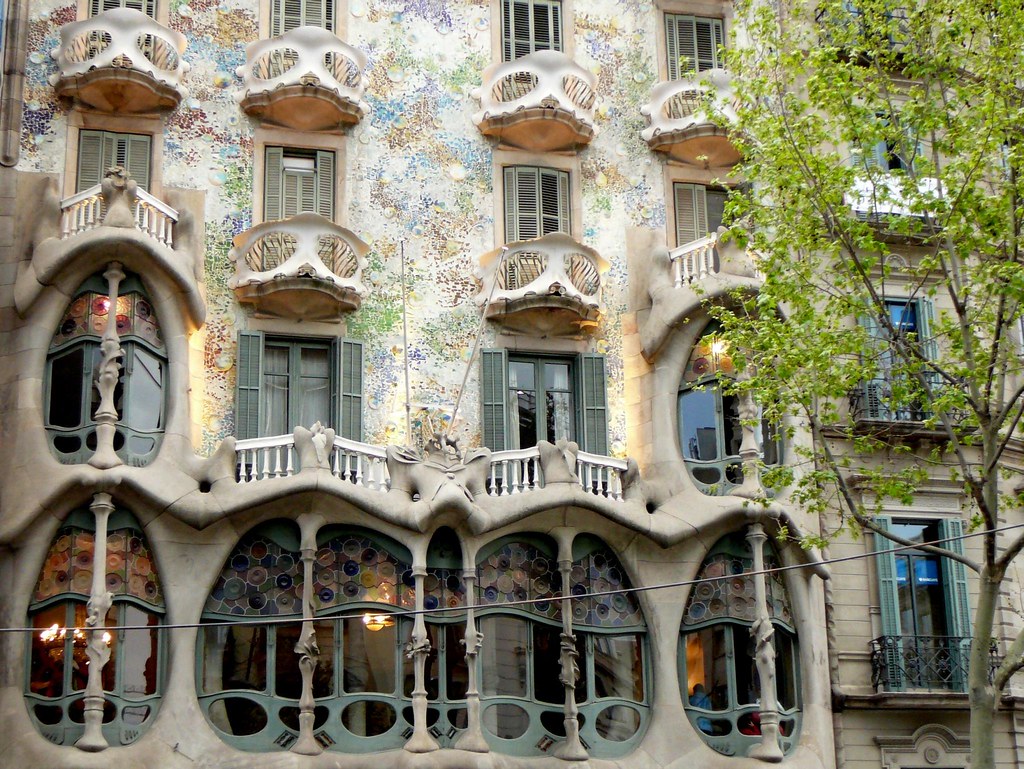 The Casa Batlló, a remodeled nineteenth century building, is one of Gaudí’s many masterpieces in Barcelona. Often overlooked for La Pedrera, La Casa Batllo is equally as stunning with its unique architecture and infamous two ornamental pillars in the entrance to the terrace. Its unique interior is just as extraordinary as its fairytale-like exterior.
The Casa Batlló, a remodeled nineteenth century building, is one of Gaudí’s many masterpieces in Barcelona. Often overlooked for La Pedrera, La Casa Batllo is equally as stunning with its unique architecture and infamous two ornamental pillars in the entrance to the terrace. Its unique interior is just as extraordinary as its fairytale-like exterior.Casa Batlló is one of the two great buildings designed by Antoni Gaudí on Passeig de Gràcia, the other being La Pedrera.
From the outside the façade of Casa Batlló looks like it has been made from skulls and bones. The "Skulls" are in fact balconies and the "bones" are supporting pillars. Gaudí used colours and shapes found in marine life as inspiration for his creativity in this building.
This building is a stunningly original work and well worth the visit. If you decide to take a look around inside you will learn how much attention to detail Gaudí spent on his designs thinking about such things as varying window size depending on how high the window is from the top of the building. In this way he could ensure uniform lighting conditions in each room of the house. The audio tour that comes with the entrance ticket gives you fascinating insights into Gaudí and his influences when designing this house.
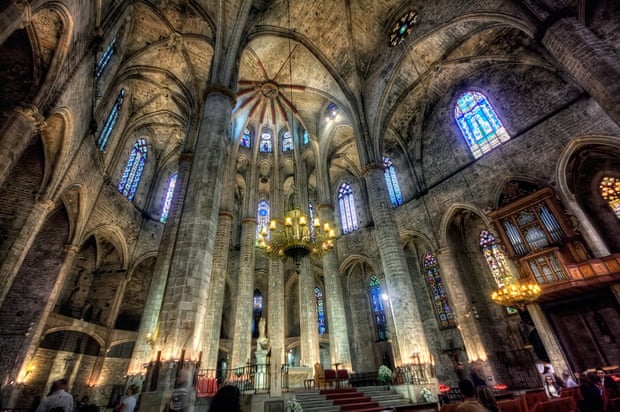 The church of Santa Maria del Mar, built in the 14th century, is one of the landmarks of Barcelona. It is located in the middle of the La Ribera district. It is considered one of the most beautiful Gothic style churches in the world.
The church of Santa Maria del Mar, built in the 14th century, is one of the landmarks of Barcelona. It is located in the middle of the La Ribera district. It is considered one of the most beautiful Gothic style churches in the world.
While Barcelona's cathedral was the centre of the old city, this church became the main building of what was then the new part of the city, next to the sea, in which a nucleus of merchants and shipowners settled. The speed at which the new church was built – 55 years - was an incredible feat at a time when most churches took longer than a century to construct, and makes it a rare example of pure Gothic architecture. The unique harmony and elegance of this church's interior will take your breath away. The inside of the Santa Maria del Mar is particularly worth a visit.
La Boqueria market:
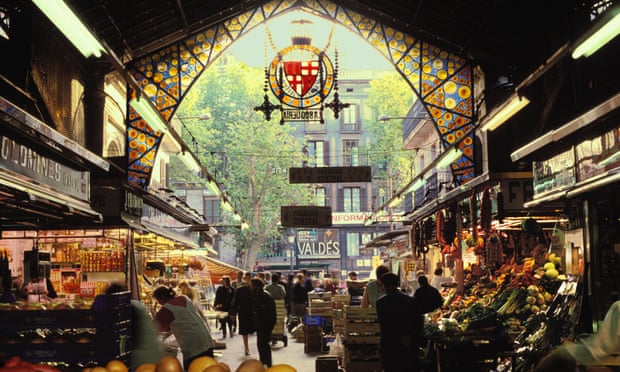 About two thirds of the way up the Ramblas, on the left, you will see one of Europe's largest and most famous food markets. Food plays a big part in Catalan culture, and there's no better way to get a taste of local cuisine than exploring the city's markets.
About two thirds of the way up the Ramblas, on the left, you will see one of Europe's largest and most famous food markets. Food plays a big part in Catalan culture, and there's no better way to get a taste of local cuisine than exploring the city's markets.The Boqueria's grand iron entrance leads to a fully functioning world of food that throngs with both tourists and locals. The floors are slippy with melted ice and fruit skins and the stall holders are loud, but this all adds to the charm of the experience. You will find foods of all varieties and nationalities under one roof.
It is best to get to the market in the morning, as this is when the market is in full swing. Dotted around the market there are bars selling both food and drink. It is a great place to get lunch or a light snack. The Boqueria Food Market is a must-see during a trip to Barcelona. Specialist stalls selling many and varied options of olives, seafood, fruit, meats, cheeses and much more are all on offer. Whether you buy some picnic ingredients, feast at one of the tapas bars or simply take a look, you are guaranteed to have a memorable experience.
Montjuic:
Monjuic is a scenic wooded hill in the South West of Barcelona. It gets it's name from the Catalan meaning 'Jewish Mountain', and was once the home of the city's Jewish community
The eastern side of the hill is almost a sheer cliff, giving it a commanding view over the city’s harbor immediately below. The top of the hill was the site of several fortifications, the latest of which remains today.
On the hill you will find the fabulous Palau Nacional, a majestic palace which now hosts the the Museum of Catalan Art and the Font Magica - an impressive waterworks which spurts to the tune of classical music and still functions today, and Poble Espanyol, a mock-Spanish village designed to showcase the various regional styles of archictecture on the peninsula, which has subsequently become one of Barcelona's most popular tourist attractions.
The best way to get up to Monjuic is to take the cable car. The cable car links the city to the top of Montjuïc. To do so, its glazed cars climb 84.5 metres on a 750-metre run that shows the whole of Barcelona, from the Serra de Collserola to the sea. The cable car has three stations: Parc de Montjuïc, Miramar and Castell de Montjuïc. There is much to see when you get to the top of Monjuic, and you could easily spend most of a day and evening there.
Font Magica:
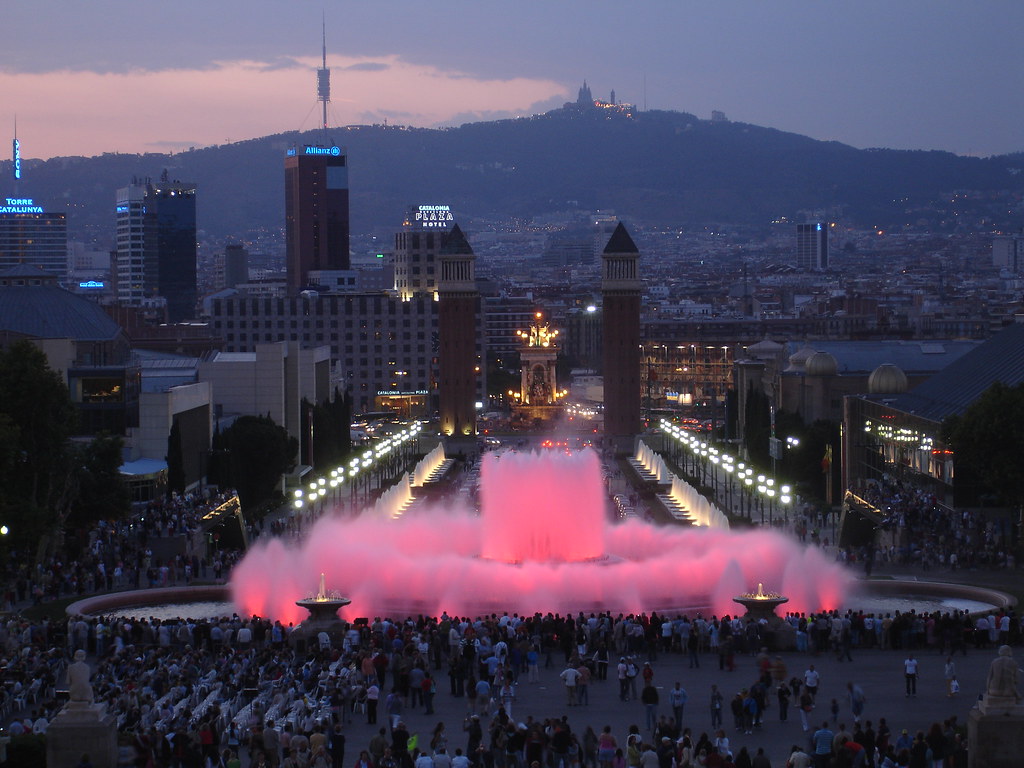 Font Màgica is a fountain located below the Palau Nacional on the Montjuïc hill and near the Plaça d’Espanya and Poble Espanyol de Barcelona. The fountain, like most of the surrounding developments, was constructed for the 1929 Barcelona International Exposition. More than 100 hydraulic valves are used to spout water and some 4,000 lights illuminate the fountain
Font Màgica is a fountain located below the Palau Nacional on the Montjuïc hill and near the Plaça d’Espanya and Poble Espanyol de Barcelona. The fountain, like most of the surrounding developments, was constructed for the 1929 Barcelona International Exposition. More than 100 hydraulic valves are used to spout water and some 4,000 lights illuminate the fountainOn selected evenings, when the fountain is activated, it attracts hundreds of visitors who watch the spectacular display of light, water and music. At the same time, the Palau National is illuminated, providing a beautiful background.
There are many more things to see in the city of Barcelona. Just exploring the city and taking some time to wander down side streets, have a beer and watch the people, and do some shopping, I am sure we will have no problem filling up our week. But I would also like to take a couple of side trips before we leave that area.
There are so many places near Barcelona to explore. There is the Costa Brava area, Girona, Figueres, Bealu, Rupit, Carcossone & Andorra. Since we are going with another couple (our Scottish friends), where we go will be decided by the group, and we will probably decide while there. After our week in Barcelona, our friends will head home. We will then pick up a car and drive up the coast of France, exploring as we go, ending in Arles, France, where we will pick up our river cruise to Lyon. We will spend 4 nights in Paris at the end of the trip, where I will get to take one thing off my list. We plan on doing a day trip over to Monet's home. So my next destination series that I will write will be the area we will explore from Barcelona to Monte Carlo and beyond.

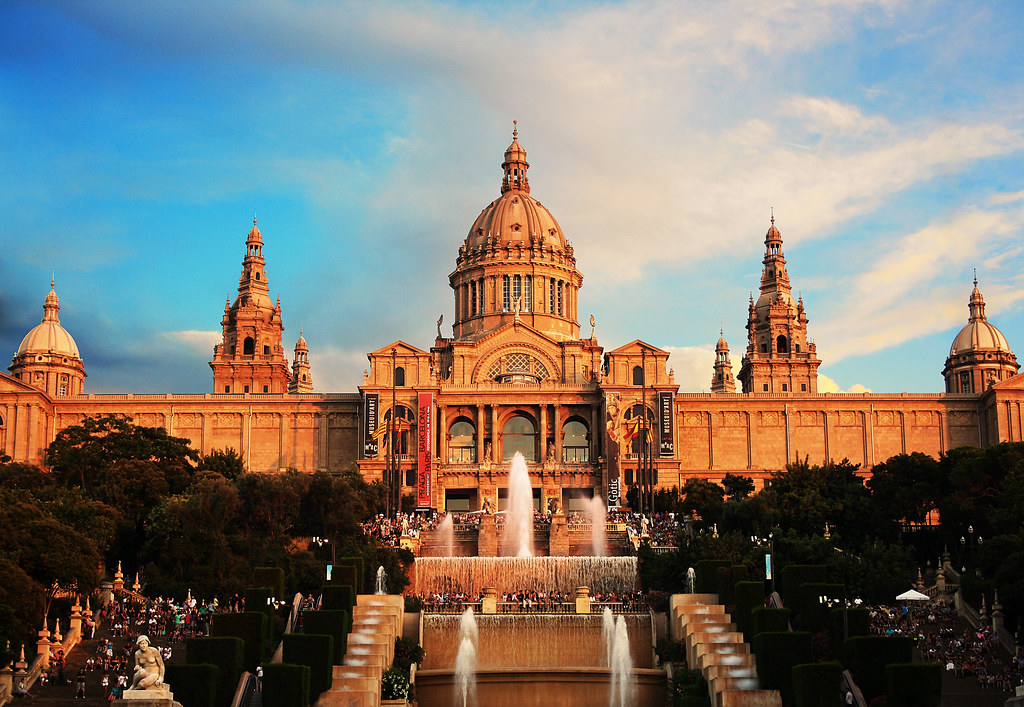
No comments:
Post a Comment